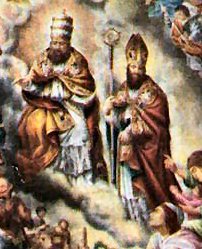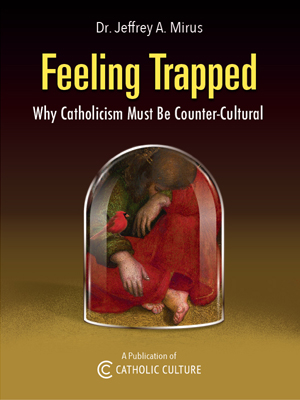Ordinary Time: September 16th
Memorial of Sts. Cornelius, pope and martyr and Cyprian, bishop and martyr
Other Commemorations: St. Ninian, Bishop (Scotland, Feast; RM); Sts. Euphemia, Martyr (RM); St. Ninian, Bishop (RM); Bl. Victor III, Pope (RM); St. Juan Macias, Religious (RM)
» Enjoy our Liturgical Seasons series of e-books!
Today the Church commemorates two friends in the service of Christ and his Church. Cornelius, a Roman, was the twenty-first Pope during the reign of the Emperor Gallus and Volusian. He had to oppose Novatian, the first anti-pope, who believed that apostates who repented could not be forgiven. Helped by St. Cyprian, Cornelius confirmed his papal authority. He was beheaded in exile at Civitavecchia, Italy in 253. Saints Cyprian and Cornelius are mentioned in the Roman Canon (Eucharistic Prayer I) of the Mass.
According to the 1962 Missal of St. John XXIII the Extraordinary Form of the Roman Rite, today is the feast of the commemoration of Sts. Euphemia, Lucy and Geminianus. Veneration of St. Euphemia, a virgin of Chalcedon martyred under Diocletian, was widespread in the East. Over her tomb was built the basilica in which assembled the Council of Chalcedon in 451. St. Euphemia was also venerated in the West, especially in Italy. St. Lucy is the martyr of Syracuse. Little is known of St. Geminianus whose cult is associated with that of St. Lucy.
St. Cornelius
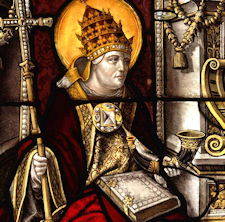 Pope Cornelius (251-253) was the successor to Pope Fabian. During his reign a controversy arose concerning the manner of reinstating those who had fallen from the faith under the duress of persecution. The Novatians accused the Pope of too great indulgence and separated themselves from the Church. With the help of St. Lucina, Cornelius transferred the remains of the princes of the apostles to places of greater honor. On account of his successful preaching the pagans banished him to Centumcellae, where he died. St. Cyprian sent him a letter of condolence. At the time of Pope Cornelius there were at Rome forty-six priests, seven deacons, seven subdeacons, forty-two acolytes, fifty-two clerics and more than five hundred widows who were supported by the Church (according to Cornelius' letter to Bishop Fabian of Antioch).
Pope Cornelius (251-253) was the successor to Pope Fabian. During his reign a controversy arose concerning the manner of reinstating those who had fallen from the faith under the duress of persecution. The Novatians accused the Pope of too great indulgence and separated themselves from the Church. With the help of St. Lucina, Cornelius transferred the remains of the princes of the apostles to places of greater honor. On account of his successful preaching the pagans banished him to Centumcellae, where he died. St. Cyprian sent him a letter of condolence. At the time of Pope Cornelius there were at Rome forty-six priests, seven deacons, seven subdeacons, forty-two acolytes, fifty-two clerics and more than five hundred widows who were supported by the Church (according to Cornelius' letter to Bishop Fabian of Antioch).
—Excerpted from The Church's Year of Grace, Pius Parsch
Patronage: against earache; against epilepsy; against fever; against twitching; cattle; domestic animals; earache sufferers; epileptics; Albano Sant’Alessandro, Italy; Kornelimünster, Germany
Symbols and Representation: horn and triple papal cross; cows or oxen; font; tall cross; sword; also papal symbols of tiara, church and/or triple cross; martyr's crown; palm frond (for martyr); papal tiara.
Highlights and Things to Do:
- Read more about St. Pope Cornelius:
- Catholic Cuisine has an idea for Orecchiette "Little Ears" Pasta for St. Cornelius.
St. Cyprian
Patronage: Algeria (proclaimed on 6 July 1914 by Pope Pius X); North Africa; Albano Sant’Alessandro, Italy
Symbols and Representation: Twenty gold coins; crown; axe; palm frond (for martytr); martyr's crown; bishop's mitre
Highlights and Things to Do: Sts. Euphemia of Chalcedon
Patronage: Alba Adriatica, Italy; Rovinj, Croatia
Often Depicted As: with a lion or bear or snakes, stabbed with a sword, holding a lily and palm of martyrdom
Highlights and Things To Do: St. Ninian
The most important later life, compiled in the twelfth century by St. Ælred, professes to give a detailed account founded on Bede and also on a "liber de vita et miraculis eius" (sc. Niniani) "barbarice scriptus", but the legendary element is largely evident. He states, however, that while engaged in building his church at Candida Casa, Ninian heard of the death of St. Martin and decided to dedicate the building to him. Now St. Martin died about 397 so that the mission of Ninian to the southern Picts must have begun towards the end of the fourth century. St. Ninian founded at Whithorn a monastery which became famous as a school of monasticism within a century of his death; his work among the southern Picts seems to have had but a short-lived success. St. Patrick, in his epistle to Coroticus, terms the Picts "apostates", and references to Ninian's converts having abandoned Christianity are found in Sts. Columba and Kentigern. The body of St. Ninian was buried in the church at Whithorn (Wigtownshire), but no relics are now known to exist. The "Clogrinny", or bell of St. Ringan, of very rough workmanship, is in the Antiquarian Museum at Edinburgh.
Patronage: The diocese of Antigonish, Nova Scotia, Canada and the diocese of Galloway, Scotland
Often Represented As: bishop with crozier and book
Highlights and Things to Do: Blessed Pope Victor III
Taking office as pope on May 24, 1086, Victor had little time or energy to do much, given his age and the tenuous situation with Antipope Clement III lurking in and out of Rome. It’s said that Victor was hardly able to make it through an entire Mass during his time as pope due to ill health. He’s credited with authoring a work on the miracles of St. Benedict and other saints at Monte Cassino. Pope Victor III died September 16, 1087 and is buried in the abbey he called home for nearly three decades.
Highlights and Things to Do: St. Juan Macias (or John Massias)
Now while many historians might try to avoid talk of miracles and the supernatural and look solely at the heroic sanctity of saints, sometimes it is good to look at how God can work in these scientifically unexplainable ways. And even though St. Juan Macias wasn’t known to be a miracle worker of the magnitude of saints like St. Vincent Ferrer or St. Martin de Porres, he still lived a life full of supernatural graces. For instance, he was attacked by demons from the moment that he enter the Order, he had visions of St. John the Evangelist throughout his life, he would disappear when the overly curious or wealthy were looking at him, and he was visited by many of the souls whom he had liberated from Purgatory (he is said to have freed more than a million through his prayers and sacrifices – talk about devotion to the souls in Purgatory).
He was well known mainly for two things during his life. First, he was known to love the Rosary, which he began to pray as a child in Spain while he shepherded his uncle’s flock of sheep. He would pray the Rosary constantly, especially when he had any moment of free time. Secondly, he was known for his generosity to the poor, 200 of whom he fed every day.
He was greatly aided in this by his little donkey that he sent through Lima. He had a little sign which put on it asking for donations for the poor. The donkey, knowing his route perfectly, would travel through the streets and come back with benefactions for the city’s poor. Often the donkey would stop at certain locations and make loud noises so that the people inside would come out to make their donations.
St. Juan Macias was beatified with St. Martin de Porres in 1837 by Pope Gregory XVI and was canonized in 1975 by Pope Paul VI.
Highlights and Things To Do: 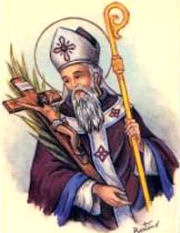 Thascius Caecilius Cyprianus, illustrious as a pagan rhetorician in Carthage, embraced the true faith in the year 246 and was soon thereafter consecrated priest and bishop of that city (248). He was an energetic shepherd of souls and a prolific writer. He defended the unity of the Church against schismatic movements in Africa and Italy, and greatly influenced the shaping of Church discipline relative to reinstating Christians who had apostatized. He fled during the Decian persecution but guided the Church by means of letters. During the Valerian persecution (258) he was beheaded. He suffered martyrdom in the presence of his flock, after giving the executioner twenty-five pieces of gold. St. Jerome says of him: "It is superfluous to speak of his greatness, for his works are more luminous than the sun." Cyprian ranks as an important Church Father, one whose writings are universally respected and often read in the Divine Office. His principal works are: On the Unity of the Church; On Apostates; a collection of Letters;
Thascius Caecilius Cyprianus, illustrious as a pagan rhetorician in Carthage, embraced the true faith in the year 246 and was soon thereafter consecrated priest and bishop of that city (248). He was an energetic shepherd of souls and a prolific writer. He defended the unity of the Church against schismatic movements in Africa and Italy, and greatly influenced the shaping of Church discipline relative to reinstating Christians who had apostatized. He fled during the Decian persecution but guided the Church by means of letters. During the Valerian persecution (258) he was beheaded. He suffered martyrdom in the presence of his flock, after giving the executioner twenty-five pieces of gold. St. Jerome says of him: "It is superfluous to speak of his greatness, for his works are more luminous than the sun." Cyprian ranks as an important Church Father, one whose writings are universally respected and often read in the Divine Office. His principal works are: On the Unity of the Church; On Apostates; a collection of Letters;
—Excerpted from The Church's Year of Grace, Pius Parsch
Listen to Catholic Culture's podcasts on St. Cyprian:
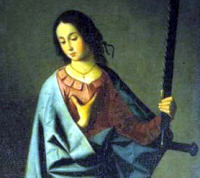 At Chalcedon, were the deaths of St. Euphemia, virgin and martyr, under Emperor Diocletian and the proconsul Priscus. For her faith in our Lord she was subjected to tortures, imprisonment, blows, the torment of the wheel, fire, the crushing weight of stones, the teeth of the beasts, scourging with rods, the cutting of sharp saws, and burning pans, all of which she survived. But when she was again exposed to the beasts in the amphitheater, praying to our Lord to receive her spirit, one of the animals inflicted a bite on her holy body although the rest of them licked her feet, and she yielded her unspotted soul to God . . . At Rome, the holy martyrs Lucy, a noble matron, and Geminanus, were subjected to grievous afflictions and were for a long time tortured by the command of Emperor Diocletian. Finally, being put to the sword, they obtained the glorious victory of martyrdom.
At Chalcedon, were the deaths of St. Euphemia, virgin and martyr, under Emperor Diocletian and the proconsul Priscus. For her faith in our Lord she was subjected to tortures, imprisonment, blows, the torment of the wheel, fire, the crushing weight of stones, the teeth of the beasts, scourging with rods, the cutting of sharp saws, and burning pans, all of which she survived. But when she was again exposed to the beasts in the amphitheater, praying to our Lord to receive her spirit, one of the animals inflicted a bite on her holy body although the rest of them licked her feet, and she yielded her unspotted soul to God . . . At Rome, the holy martyrs Lucy, a noble matron, and Geminanus, were subjected to grievous afflictions and were for a long time tortured by the command of Emperor Diocletian. Finally, being put to the sword, they obtained the glorious victory of martyrdom.
—Excerpted from The Roman Martyrology
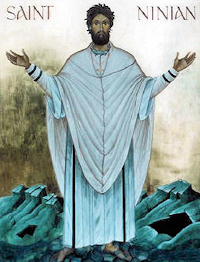 Bishop and confessor; date of birth unknown; died about 432; the first Apostle of Christianity in Scotland. The earliest account of him is in Bede (Hist. Eccles., III, 4): "the southern Picts received the true faith by the preaching of Bishop Ninias, a most reverend and holy man of the British nation, who had been regularly instructed at Rome in the faith and mysteries of the truth; whose episcopal see, named after St. Martin the Bishop, and famous for a church dedicated to him (wherein Ninias himself and many other saints rest in the body), is now in the possession of the English nation. The place belongs to the province of the Bernicians and is commonly called the White House [Candida Casa], because he there built a church of stone, which was not usual amongst the Britons." The facts given in this passage form practically all we know of St. Ninian's life and work.
Bishop and confessor; date of birth unknown; died about 432; the first Apostle of Christianity in Scotland. The earliest account of him is in Bede (Hist. Eccles., III, 4): "the southern Picts received the true faith by the preaching of Bishop Ninias, a most reverend and holy man of the British nation, who had been regularly instructed at Rome in the faith and mysteries of the truth; whose episcopal see, named after St. Martin the Bishop, and famous for a church dedicated to him (wherein Ninias himself and many other saints rest in the body), is now in the possession of the English nation. The place belongs to the province of the Bernicians and is commonly called the White House [Candida Casa], because he there built a church of stone, which was not usual amongst the Britons." The facts given in this passage form practically all we know of St. Ninian's life and work.
—Excerpted from New Advent
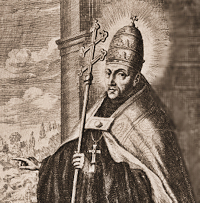 Blessed Pope Victor III was born a Prince of the dukes of Benevento around the year 1026, the only son of Prince Landulf V. Victor was always monastically inclined, having skillfully avoided not one, but two arranged marriages before opting for life as a hermit and monk. He eventually entered the monastery of Monte Cassino, where he succeeded Abbot Frederick when the latter was elected Pope Stephen IX. As abbot, Victor (then Desiderius) became renowned as the greatest abbot the monastery had seen since St. Benedict himself.
Blessed Pope Victor III was born a Prince of the dukes of Benevento around the year 1026, the only son of Prince Landulf V. Victor was always monastically inclined, having skillfully avoided not one, but two arranged marriages before opting for life as a hermit and monk. He eventually entered the monastery of Monte Cassino, where he succeeded Abbot Frederick when the latter was elected Pope Stephen IX. As abbot, Victor (then Desiderius) became renowned as the greatest abbot the monastery had seen since St. Benedict himself.
—Excerpted from Flocknote
St. Juan Macias lived in Lima, Peru at the same time as St. Martin de Porres and only 5 years after the death of St. Rose of Lima. Originally from Spain, St. Juan Macias first met the Dominicans at the age of 16 but was told in a revelation that he wasn’t to enter yet. Later, he traveled to the New World, and at the age of 35, he entered the Dominican convent of St. Mary Magdalene in Lima (St. Martin was in the convent of Santo Domingo, otherwise known as Holy Rosary) as a laybrother (cooperator brothers were called laybrothers then).
—Excerpted from Dominican Friars, Province of St. Joseph


